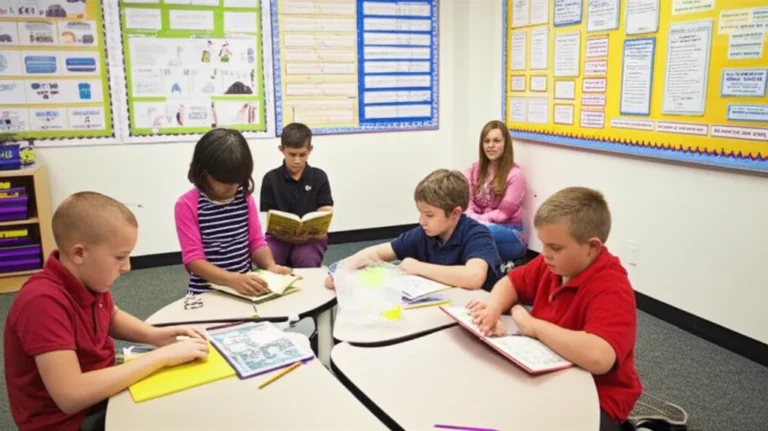Support our educational content for free when you buy through links on our site. Learn more
25+ Game-Changing Strategies for Differentiating Instruction in 2025 🎯
Imagine walking into a classroom where every student feels seen, challenged, and inspired—no matter their learning style, background, or ability. Sounds like a dream, right? Well, it’s entirely possible with the right differentiated instruction strategies
. In this article, we’re diving deep into 25+ proven ways to tailor your teaching to meet the diverse needs of your students. From tech tools like Prodigy to flexible grouping and Universal Design for Learning principles, we’ve got the ultimate playbook to help you transform your classroom into an inclusive powerhouse.Did you know that classrooms using differentiated instruction report significantly higher student engagement and motivation? According to a study by the National Institutes of Health, personalized learning approaches not only boost academic success but also foster self-confidence and resilience. Stick around, because later we’ll share insider tips from veteran educators and must-have resources that will make differentiation feel doable—and even fun!
Key Takeaways
- Differentiated instruction meets students where they are by adapting content, process, and product based on readiness, interests, and learning profiles.
- 25+ practical strategies include tiered assignments, flexible grouping, choice boards, and assistive technology tools like Prodigy and Read&Write.
- Ongoing formative assessment is essential to guide and adjust instruction in real time.
- Universal Design for Learning (UDL) principles help create inclusive lessons that benefit all learners from the start.
- Collaboration with specialists and student involvement enhance the effectiveness of differentiation.
- Professional development and continuous learning empower teachers to refine their differentiation skills over time.
Ready to unlock the full potential of your classroom? Let’s dive in!
Table of Contents
- ⚡️ Quick Tips and Facts on Differentiating Instruction
- 📚 The Evolution of Differentiated Instruction: Meeting Diverse Student Needs
- 🎯 Understanding Student Diversity: Learning Styles, Abilities, and Backgrounds
- 🛠️ 25 Proven Strategies for Differentiating Instruction in the Classroom
- 1. Tiered Assignments: Tailoring Tasks to Readiness Levels
- 2. Flexible Grouping: Dynamic Collaboration for Varied Learners
- 3. Learning Stations and Centers: Engaging Multiple Modalities
- 4. Choice Boards and Menus: Empowering Student Voice
- 5. Use of Technology and Adaptive Tools
- 6. Scaffolded Instruction: Building Skills Step-by-Step
- 7. Compacting Curriculum for Advanced Learners
- 8. Incorporating Student Interests and Cultural Relevance
- 9. Ongoing Formative Assessments to Guide Instruction
- 10. Personalized Learning Plans and Goal Setting
- 11. Multisensory Teaching Approaches
- 12. Peer Tutoring and Cooperative Learning
- 13. Visual Supports and Graphic Organizers
- 14. Adjusting Pacing and Time Frames
- 15. Incorporating Social-Emotional Learning Strategies
- 16. Using Real-World Connections and Problem-Based Learning
- 17. Differentiating Homework and Independent Practice
- 18. Leveraging Assistive Technologies for Accessibility
- 19. Providing Multiple Means of Expression and Assessment
- 20. Incorporating Universal Design for Learning (UDL) Principles
- 21. Using Data-Driven Instruction to Inform Differentiation
- 22. Collaborative Planning with Special Educators and Support Staff
- 23. Encouraging Student Self-Assessment and Reflection
- 24. Creating a Classroom Culture that Values Diversity
- 25. Professional Development and Continuous Learning for Teachers
- 🔍 Tools and Resources to Support Differentiated Instruction
- 📈 Measuring Success: How to Assess the Impact of Differentiation
- 💡 Expert Tips and Anecdotes from Veteran Educators
- 📖 Recommended Reading and Online Courses on Differentiated Instruction
- ❓ Frequently Asked Questions About Differentiating Instruction
- 🔗 Reference Links and Credible Sources for Further Exploration
- 🎉 Conclusion: Embracing Diversity with Differentiated Instruction
⚡️ Quick Tips and Facts on Differentiating Instruction
Welcome to the vibrant world of differentiated instruction—where one size definitely does not fit all! At Teacher Strategies™, we’ve seen firsthand how tailoring teaching to meet diverse student needs transforms classrooms into buzzing hubs of engagement and success. Here are some quick nuggets to get you started:
- ✅ Differentiated instruction boosts student engagement and achievement by addressing individual learning styles, readiness levels, and interests.
- ✅ Flexible grouping and tiered assignments are among the most effective strategies to personalize learning.
- ✅ Technology tools like Prodigy and Google Classroom can support adaptive learning paths.
- ✅ Ongoing formative assessment is your best friend for knowing when and how to differentiate.
- ✅ Differentiation is not about creating dozens of lesson plans but about smartly adjusting content, process, and product.
Did you know? According to a study published by the National Institutes of Health, differentiation improves not only academic outcomes but also student motivation and self-efficacy. So, if you’ve ever wondered how to juggle the many faces of your classroom, you’re in the right place!
For more on how to get started, check out our detailed Instructional Strategies resources.
📚 The Evolution of Differentiated Instruction: Meeting Diverse Student Needs
Differentiated instruction didn’t just pop up overnight—it’s the result of decades of educational research and practice evolving to meet the reality of diverse classrooms. Let’s take a quick stroll down memory lane:
- Origins: The term “differentiation” comes from Latin differentia, meaning distinction or difference. Early educational theorists recognized that learners are unique, but it wasn’t until Howard Gardner’s Multiple Intelligences Theory in the 1980s that differentiation gained scientific backing. Gardner’s work expanded the idea of intelligence beyond IQ to include linguistic, spatial, kinesthetic, musical, interpersonal, and more.
- From Theory to Practice: In the 1990s and 2000s, Carol Ann Tomlinson popularized differentiated instruction as a practical framework for teachers. Her approach emphasized adapting content, process, and product based on student readiness, interests, and learning profiles.
- Modern Trends: Today, differentiation embraces Universal Design for Learning (UDL), technology integration, and social-emotional learning. The goal? To create classrooms where every student feels valued and empowered.
As Russell Jay Hendel highlights, differentiation is a transdisciplinary approach—drawing from architecture (UDL), neuroscience (multimodal learning), and psychology (goal-setting and self-efficacy).
Curious how these theories translate into actionable strategies? Hold tight—we’re diving deep next!
🎯 Understanding Student Diversity: Learning Styles, Abilities, and Backgrounds
Before you can tailor your instruction, you need to understand the rich tapestry of your students’ needs. Here’s what we at Teacher Strategies™ emphasize:
Learning Styles and Multiple Intelligences
- Visual learners thrive on images, charts, and graphic organizers.
- Auditory learners prefer discussions, lectures, and audio materials.
- Kinesthetic learners learn best through hands-on activities and movement.
- Linguistic learners excel with reading and writing tasks.
- Interpersonal learners enjoy group work and social interaction.
Pro tip: Use quick surveys or informal interviews early in the year to identify these preferences.
Readiness Levels and Prior Knowledge
Students come with varying mastery of skills and concepts. Differentiation means meeting each where they are—whether that’s scaffolding for those who need extra support or compacting curriculum for advanced learners.
Cultural and Linguistic Backgrounds
Recognizing students’ cultural contexts and language proficiency is critical. Incorporate culturally relevant materials and provide language supports to ensure equity.
Social-Emotional Factors
Students’ motivation, self-confidence, and emotional well-being impact learning. Differentiated instruction that includes social-emotional learning strategies helps create a safe and supportive environment.
Want to explore more about learning styles? Check out our Differentiated Instruction category.
🛠️ 25 Proven Strategies for Differentiating Instruction in the Classroom
Ready to roll up your sleeves? Here’s a comprehensive toolkit of strategies, each backed by research and classroom-tested by our Teacher Strategies™ experts. We’ve numbered these to keep you on track!
1. Tiered Assignments: Tailoring Tasks to Readiness Levels
What it is: Assignments designed at varying levels of complexity but focused on the same core concept.
How to implement:
- Identify the learning goal.
- Create three or more versions of the task: basic, intermediate, and advanced.
- Assign students based on readiness or let them choose their challenge level.
Benefits:
- Keeps all students engaged without watering down content.
- Encourages growth by meeting students where they are.
Example: In a history lesson on the Civil War, some students might analyze primary source documents, others summarize key events, while advanced learners debate causes and effects.
2. Flexible Grouping: Dynamic Collaboration for Varied Learners
What it is: Changing student groups frequently based on skill, interest, or learning style.
Tips:
- Use small groups, pairs, or whole-class discussions.
- Rotate groups to expose students to diverse perspectives.
- Group by readiness for targeted instruction or by interest for motivation.
Why it works:
- Prevents social stagnation and encourages peer learning.
- Allows teachers to tailor instruction more precisely.
3. Learning Stations and Centers: Engaging Multiple Modalities
Description: Set up different areas in the classroom, each with a unique activity targeting a skill or concept.
Implementation:
- Design stations for visual, auditory, and kinesthetic learners.
- Rotate students through stations in small groups or individually.
- Use technology stations with apps like Khan Academy or Prodigy for adaptive practice.
Benefits:
- Active learning boosts retention.
- Students can work at their own pace.
4. Choice Boards and Menus: Empowering Student Voice
What they are: Grids or menus offering a variety of tasks aligned with learning objectives, letting students pick what appeals to them.
Why use them:
- Increases motivation by giving autonomy.
- Addresses different learning preferences.
Example: For a science unit, choices might include creating a poster, writing a report, filming a video, or building a model.
5. Use of Technology and Adaptive Tools
Technology is a game-changer for differentiation. Here are some favorites:
| Tool | Purpose | Highlights |
|---|---|---|
| Prodigy | Adaptive math practice | Free, standards-aligned, engaging game-based learning (Prodigy on Amazon) |
| Google Classroom | Organizing assignments and feedback | Easy to assign differentiated tasks and track progress |
| Kahoot! | Interactive quizzes | Real-time feedback and engagement |
| Read&Write by Texthelp | Supports reading and writing | Assistive tech for diverse learners |
Tip: Use data from these tools to inform your instruction and groupings.
6. Scaffolded Instruction: Building Skills Step-by-Step
Break complex tasks into manageable chunks, providing support at each stage. Gradually remove supports as students gain independence.
Example: In writing, start with brainstorming, then outline, draft, revise, and finally publish.
7. Compacting Curriculum for Advanced Learners
Pre-assess students to identify mastery. Allow those who demonstrate proficiency to skip redundant lessons and engage in enrichment or acceleration activities.
8. Incorporating Student Interests and Cultural Relevance
Connect content to students’ lives and cultures to boost engagement and relevance.
Example: Use literature from diverse authors or math problems involving culturally familiar contexts.
9. Ongoing Formative Assessments to Guide Instruction
Use quizzes, exit tickets, observations, and discussions to gauge understanding continuously. Adjust instruction accordingly.
10. Personalized Learning Plans and Goal Setting
Work with students to set achievable goals and track progress. This fosters ownership and motivation.
11. Multisensory Teaching Approaches
Engage multiple senses to reinforce learning—think visual aids, hands-on activities, music, and movement.
12. Peer Tutoring and Cooperative Learning
Pair students strategically so they can support each other’s learning. This builds social skills and deepens understanding.
13. Visual Supports and Graphic Organizers
Use mind maps, flowcharts, and Venn diagrams to help students organize and process information visually.
14. Adjusting Pacing and Time Frames
Allow students to work at different speeds. Some may need extra time; others may be ready to move ahead.
15. Incorporating Social-Emotional Learning Strategies
Teach skills like self-regulation, empathy, and resilience to support learning readiness and classroom climate.
16. Using Real-World Connections and Problem-Based Learning
Anchor lessons in practical, authentic problems to increase relevance and critical thinking.
17. Differentiating Homework and Independent Practice
Assign tasks that vary in complexity or format to suit individual needs and encourage autonomy.
18. Leveraging Assistive Technologies for Accessibility
Tools like speech-to-text, audiobooks, and screen readers help students with disabilities access content.
19. Providing Multiple Means of Expression and Assessment
Allow students to demonstrate learning via essays, presentations, videos, art, or portfolios.
20. Incorporating Universal Design for Learning (UDL) Principles
Design lessons that provide multiple means of engagement, representation, and expression from the start to accommodate all learners.
21. Using Data-Driven Instruction to Inform Differentiation
Analyze assessment data to identify trends and tailor instruction accordingly.
22. Collaborative Planning with Special Educators and Support Staff
Work with specialists to design accommodations and modifications that fit student needs.
23. Encouraging Student Self-Assessment and Reflection
Teach students to evaluate their own work and set goals, fostering metacognition and responsibility.
24. Creating a Classroom Culture that Values Diversity
Celebrate differences and create an inclusive environment where every student feels respected and supported.
25. Professional Development and Continuous Learning for Teachers
Stay updated on best practices through workshops, webinars, and peer collaboration. Differentiation is a skill that grows with experience.
🔍 Tools and Resources to Support Differentiated Instruction
To make differentiation manageable and effective, leverage these trusted tools and resources:
| Resource | Description | Link |
|---|---|---|
| Prodigy Math Game | Adaptive math platform that adjusts to student needs | Prodigy Official |
| Google Classroom | Assignment management and feedback | Google Classroom |
| Khan Academy | Free lessons and practice in multiple subjects | Khan Academy |
| Read&Write by Texthelp | Assistive technology for reading and writing support | Texthelp |
| Teachers Pay Teachers | Marketplace for differentiated lesson plans and materials | Teachers Pay Teachers |
| Universal Design for Learning Guidelines | Framework for inclusive teaching | CAST UDL Guidelines |
Pro tip: Combine these tools with formative assessments to fine-tune your differentiation approach.
📈 Measuring Success: How to Assess the Impact of Differentiation
How do you know if your differentiation efforts are hitting the mark? Here’s our step-by-step guide:
- Set Clear, Measurable Goals: Define what success looks like for your students (e.g., improved reading comprehension, increased engagement).
- Use Formative Assessments: Frequent quizzes, exit tickets, and observations help monitor progress in real time.
- Collect Student Feedback: Surveys or informal check-ins reveal how students feel about their learning experiences.
- Analyze Work Samples: Look for evidence of growth and mastery across different assignment tiers or formats.
- Track Engagement Metrics: Attendance, participation, and behavior data can signal increased motivation.
- Reflect and Adjust: Use data to tweak your strategies continuously.
Fun fact: According to Edutopia, differentiated classrooms often see higher student motivation and lower dropout rates.
💡 Expert Tips and Anecdotes from Veteran Educators
We asked some of our seasoned Teacher Strategies™ educators to share their golden nuggets on differentiation:
-
Ms. Ramirez, 5th Grade Teacher:
“I used to think differentiation meant endless prep. Now, I focus on a few key strategies like flexible grouping and choice boards. My students love having a say in their learning, and I see real growth.” -
Mr. Chen, Special Ed Specialist:
“Collaboration with general ed teachers is crucial. When we plan together, we create seamless supports that benefit all students, not just those with IEPs.” -
Mrs. Patel, Middle School Math:
“Tech tools like Prodigy have been a lifesaver. They adapt to each student’s level, freeing me to focus on targeted small-group instruction.” -
Ms. Johnson, Literacy Coach:
“Don’t underestimate the power of student reflection. Journaling helps kids process and own their learning journey.”
Want more insider tips? Dive into our Instructional Coaching section for expert guidance.
📖 Recommended Reading and Online Courses on Differentiated Instruction
Expand your differentiation toolkit with these top picks:
| Title | Author/Provider | Format | Link |
|---|---|---|---|
| The Differentiated Classroom | Carol Ann Tomlinson | Book | ASCD |
| How to Differentiate Instruction in Academically Diverse Classrooms | Carol Ann Tomlinson | Book | Amazon |
| Universal Design for Learning: Theory and Practice | CAST | Book | CAST |
| Differentiated Instruction: Strategies for English Language Learners | Edutopia | Article | Edutopia |
| Differentiated Instruction Online Course | Coursera | Online Course | Coursera |
| Teaching Diverse Learners | Harvard Online | Online Course | Harvard Online |
❓ Frequently Asked Questions About Differentiating Instruction
Q1: Isn’t differentiation too time-consuming for busy teachers?
Absolutely understandable concern! But differentiation doesn’t mean creating dozens of lesson plans. Start small with strategies like flexible grouping or choice boards. Over time, your efficiency will improve. Plus, technology tools can lighten the load.
Q2: How do I handle a classroom with very mixed abilities?
Use tiered assignments and flexible grouping to meet students where they are. Scaffold instruction and provide enrichment for advanced learners. Remember, differentiation is about access and challenge for all.
Q3: Can differentiation work in large classrooms?
✅ Yes! It requires thoughtful planning and use of strategies like learning stations and peer tutoring. Technology can also help manage diverse needs effectively.
Q4: How do I assess students fairly if they do different tasks?
Use rubrics aligned to learning objectives that allow for multiple ways to demonstrate mastery. Focus on growth and understanding rather than identical products.
Q5: What if I don’t have support from administration?
Start with small changes and document student progress. Share successes with colleagues and leaders to build buy-in. Professional development can also empower you.
For more FAQs, visit our Assessment Techniques page.
🔗 Reference Links and Credible Sources for Further Exploration
We love backing up our advice with solid research and trusted resources. Here are some must-visit links to deepen your understanding:
- National Institutes of Health: Differentiated Instruction Strategies
- Edutopia: Differentiated Instruction Tips
- Prodigy Game Blog: 20 Differentiated Instruction Strategies
- CAST: Universal Design for Learning Guidelines
- ASCD: Carol Ann Tomlinson’s Differentiated Instruction Resources
Psst! Don’t forget to check out the featured video embedded earlier. Larry Ferlazzo’s down-to-earth explanation will make differentiation feel doable and even fun!
🎉 Conclusion: Embracing Diversity with Differentiated Instruction
So, what’s the bottom line on differentiating instruction to meet diverse student needs? It’s not just a buzzword or a lofty ideal—it’s a practical, research-backed approach that transforms classrooms into dynamic learning communities where every student can thrive. From tiered assignments to tech-powered adaptive learning, the strategies we’ve unpacked here are designed to help you meet students where they are and guide them where they need to go.
Remember the question we teased earlier: How can you juggle the many faces of your classroom without losing your mind? The answer lies in starting small, using flexible grouping, leveraging technology like Prodigy, and continuously assessing and adjusting your instruction. Differentiation is a journey, not a one-time fix.
Our Teacher Strategies™ team confidently recommends embracing a blend of strategies tailored to your unique classroom context, supported by ongoing professional development and collaboration. The payoff? Increased student engagement, motivation, and achievement—and a classroom culture that truly values diversity.
Ready to take the plunge? Your students are waiting!
🔗 Recommended Links
👉 CHECK PRICE on:
- Prodigy Math Game: Amazon | Prodigy Official Website
- Google Classroom: Google Workspace
- Khan Academy: Khan Academy Official
- Read&Write by Texthelp: Texthelp Official
- Teachers Pay Teachers: Teachers Pay Teachers Marketplace
Recommended Books on Amazon:
- The Differentiated Classroom by Carol Ann Tomlinson: Amazon Link
- How to Differentiate Instruction in Academically Diverse Classrooms by Carol Ann Tomlinson: Amazon Link
- Universal Design for Learning: Theory and Practice by CAST: Amazon Link
❓ Frequently Asked Questions About Differentiating Instruction
How can teachers tailor lessons to accommodate different learning styles?
Teachers can incorporate multisensory approaches—combining visual, auditory, kinesthetic, and tactile elements—to engage all learners. For example, pairing a lecture with graphic organizers, hands-on activities, and group discussions ensures that students with different preferences access the material meaningfully. Using choice boards allows students to select tasks that align with their learning style, increasing motivation and retention.
What are effective ways to group students for differentiated instruction?
Flexible grouping is key. Group students by readiness, interest, or learning profile, and rotate groups regularly to maximize peer learning and social interaction. Small groups allow targeted instruction, while pairing students with complementary strengths encourages collaboration. Avoid static groups to prevent labeling and ensure all students benefit from diverse interactions.
How can technology be used to support diverse learners in the classroom?
Technology tools like Prodigy adapt content to individual student levels, providing personalized practice and immediate feedback. Platforms such as Google Classroom streamline assignment distribution and progress tracking, enabling teachers to assign differentiated tasks efficiently. Assistive technologies like Read&Write support students with disabilities by offering text-to-speech, speech-to-text, and vocabulary tools.
What role does formative assessment play in differentiating instruction?
Formative assessments provide real-time data on student understanding, allowing teachers to adjust instruction promptly. Techniques include exit tickets, quizzes, observations, and student reflections. This ongoing feedback loop ensures that differentiation is responsive, targeting areas of need before misconceptions solidify.
How can educators modify assignments to challenge advanced learners while supporting struggling students?
Use tiered assignments that maintain the same learning objective but vary in complexity. Advanced learners can engage with enrichment tasks that deepen understanding or apply concepts creatively, while struggling students receive scaffolded support to build foundational skills. Compacting curriculum for proficient students frees time for extension activities.
What are some classroom management tips for implementing differentiated instruction?
Clear routines and expectations are essential. Use visual schedules for learning stations, establish norms for group work, and teach students how to self-manage during independent tasks. Consistent transitions and clear instructions reduce downtime and confusion. Positive reinforcement encourages student ownership of their learning paths.
How can teachers create inclusive lesson plans that address varying student abilities?
Plan lessons using Universal Design for Learning (UDL) principles by providing multiple means of engagement, representation, and expression. Include varied materials and activities that cater to different readiness levels and learning preferences. Collaborate with special educators to incorporate accommodations and modifications seamlessly.
How do teachers balance differentiation with curriculum standards and pacing guides?
Differentiation aligns with standards by focusing on mastery rather than uniform pacing. Teachers can prioritize essential standards and allow flexible timelines for students to demonstrate proficiency. Using formative data helps identify when to accelerate or reteach concepts, ensuring all students meet learning goals without sacrificing depth.
How can educators involve students in the differentiation process?
Encourage student choice through menus and project options. Teach self-assessment and goal-setting skills so students can reflect on their learning needs and preferences. Involving students fosters autonomy and motivation, making differentiation a collaborative journey.
🔗 Reference Links and Credible Sources for Further Exploration
- National Institutes of Health: Strategies for Differentiating Instruction
- Edutopia: 8 Differentiated Instruction Techniques
- Prodigy Game Blog: 20 Differentiated Instruction Strategies and Examples [+ Downloadable List]
- CAST: Universal Design for Learning Guidelines
- ASCD: Carol Ann Tomlinson’s Differentiated Instruction Resources
- Prodigy Official Website: https://www.prodigygame.com/
- Google Classroom: https://workspace.google.com/marketplace/category/education
- Khan Academy: https://www.khanacademy.org/
- Texthelp Read&Write: https://www.texthelp.com/en-us/products/read-write/
Ready to transform your classroom? Dive into these resources and start differentiating with confidence today! 🚀






